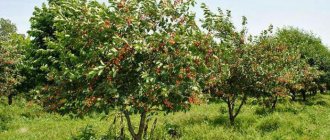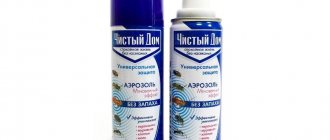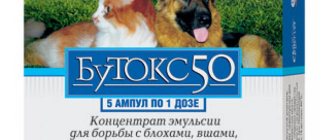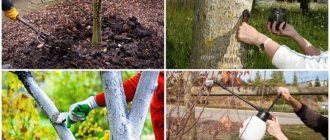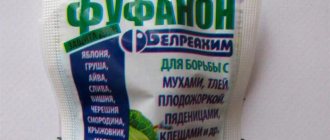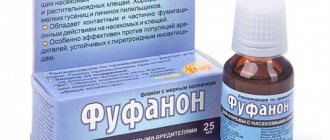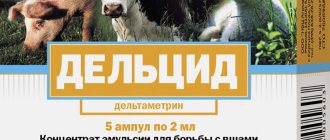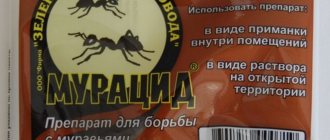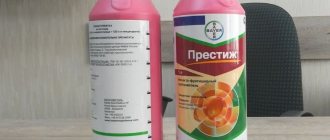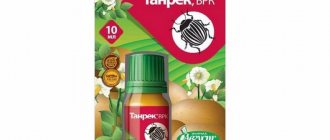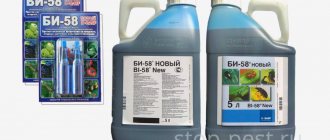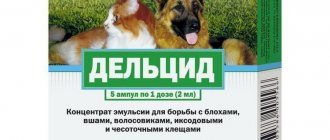Every gardener understands that it is impossible to grow a good harvest without treating pests and diseases. Now the range of chemicals is very diverse, but only some of them have a wide spectrum of action and combine acaricidal, insecticidal and fungicidal properties at the same time. One of these universal products is the spraying drug Dnok. But in order to use it correctly, you must first study the instructions.
The lasting effect of using “Dnok” lasts for 1 month
Description of the drug
Fungicide "Dnok" has a second class of toxicity. This means that if used incorrectly, it can harm plants and human health.
Compound
The fungicide is produced in the form of a yellow powder with a strong unpleasant odor. The main active ingredient is dinitroorthocresol, which is present in 40% concentration. Additional ingredients include sodium and ammonium sulfate. Thanks to this, the effectiveness of “Dnok” increases, and the active component is evenly distributed in the product.
Operating principle
When spraying plants, the fungicide “Dnok” inhibits the development of fungal spores and prevents their reproduction. And since the product also has acaricidal-insecticidal properties, it also destroys larvae and adults of wintering pest species. The maximum concentration of the active substance in plant tissues is recorded 48 hours after treating the garden with “Dnok”. You can clearly see the positive result 4 days after spraying the foliage.
Important! It is recommended to treat with this fungicide no more than once every 3 years.
What diseases and pests are they used for?
According to reviews from experienced gardeners, the “Dnok” preparation for spraying the garden simplifies plant care, since one treatment replaces several.
The preparation should be sprayed on wintering pest species:
- scale insect;
- leaf roller;
- aphid;
- mites;
- slowpoke;
- mole;
- moth;
- false scale insect;
- worm.
Due to its versatility, Dnok can be used against most fungal diseases that persist on trees, berry bushes and grapes in winter.
The use of the drug is justified when:
- spotting;
- curliness;
- moniliosis;
- scab;
- coccomycosis;
- oidium;
- anthracnose;
- necrosis;
- cercosporiosis;
- rust;
- powdery mildew;
- gray rot;
- mildy.
Important! A wide range of applications makes the Dnok fungicide one of the most effective chemicals, but we must not forget about its toxicity.
Blooming buds, ovaries, young shoots and buds are sensitive to the action of "Dnok"
Consumption rates
The amount of working preparation “Dnoka” varies depending on the crop being treated. Therefore, to achieve maximum effectiveness, you should strictly follow the instructions. Exceeding the dosage may have negative consequences for plants.
Recommended consumption of Dnoka working solution:
- 10l/100 sq. m. – stone fruit trees;
- 15l/100 sq. m. – pome crops, berry bushes;
- 8 l/10 sq. m. - grapes.
Application area
The spraying preparation "Dnok", according to the instructions for use, is intended for spring and autumn treatment of gardens and vineyards on an industrial scale. The fungicide destroys pathogens that overwinter on plants.
Can it be used by gardeners and gardeners?
Due to the high toxicity of Dnok, it is not recommended to use it privately. But, according to experts, the fungicide can be used to treat trees and shrubs if the plantings are located at a distance of 1 km from residential premises. In addition, it is important to take all precautions.
Important! Treatment with “Dnok” is recommended only when absolutely necessary, if the use of less toxic fungicides has not given a positive result.
Operating principle
The main active ingredient of the drug is 4,6-dinitro-o-cresol. Once applied to the stems and leaves, the solution destroys the fungal infection. It also effectively fights insects, stopping the disease in its infancy.
The main active ingredient of DNOC requires careful handling due to its chemical activity
After spraying, you can observe the effect after three days. Direct introduction of infectious agents into spores occurs in the first two days. During this time, the source of infection can be neutralized, and subsequently it is completely eliminated. The lasting effect lasts for another month.
Instructions for use of the drug Dnok
In accordance with the instructions, “Dnok” (double blow) must be used during certain periods of the year. And also when preparing the fungicide solution, strictly adhere to the dosage.
When is the best time to treat with Dnok?
Spraying with “Dnokom” should be done in early spring and late autumn. In the first case, it is necessary to carry out treatment until the buds appear. Therefore, when the temperature reaches above zero, not lower than +4 degrees, a fungicide should be used. It is important to have time to carry out the treatment before the sap begins to flow, since it is at this time that the product shows maximum effectiveness.
Important! During spring treatment, it is impossible for the “Dnok” solution to flow onto the soil, so you need to cover the root circle with a film or tarpaulin in advance.
In the second case, the fungicide should be used after leaf fall and after all work with the soil under bushes or trees is completed, but the air temperature should not be higher than +5 degrees.
Application of "Dnoka" in the fall involves spraying the branches, trunk and top layer of soil with fallen leaves. For this treatment, it is recommended to use a 0.5-1% fungicide solution. At low air temperatures, the active component of “Dnoka” penetrates the soil to a depth of 7 cm and thus destroys pathogens and pests that overwinter not only on the plant, but also in the top layer of soil.
Important! When applying “Dnok” in autumn, the root circle should not be covered, since during this period the fungicide is not able to affect the fertility of the soil.
Preparation of the solution
To prepare the Dnoka working solution, you must initially pour 500 ml of warm water into a separate container, and then add 50-100 g of the drug powder to it, stir thoroughly. Then increase the volume of liquid to 10 liters.
The drug is poorly soluble in cold water
Rules for using Dnok
Depending on the type of crop, the fungicide needs to be used differently. If used in spring, the concentration of the active component should not exceed 4%, which is achieved by dissolving 400 g of powder in 10 liters of water. And during autumn treatment with “Dnokom” – no more than 1% based on 100 g of product per bucket of water.
Treatment of fruit trees with Dnok
The drug "Dnok" is recommended for use on stone fruit trees (apricot, plum, cherry, peach) and pome crops (apple, pear, quince).
Treatment should be done against the following pests:
- scale insect;
- types of ticks;
- slowpoke;
- leaf roller;
- mole;
- aphid;
- psyllid;
- moth.
Also, timely spraying of trees with “Dnok” helps to destroy pathogens of curl, spotting, clasterosporiasis, coccomycosis, moniliosis and scab. The consumption rate of the fungicide working solution is 10-15 liters per 100 square meters. m of plantings.
How to use Dnok for grapes
Before processing this crop, pruning should be done first. You must begin the procedure immediately after completing the preparatory stage.
Treating grapes with “Bottom” helps prevent the spread of mites, scale insects and aphids. As a fungicide, this drug is effective against:
- anthracnose;
- oidium;
- spotting;
- cercospora;
- necrosis.
The consumption of the Dnoka working solution in this case should not exceed 8 liters per 100 sq. m. m.
It is necessary to spray before the sap begins to flow in the plants.
Spraying berry bushes with Dnok
This drug is also recommended for processing gooseberries and currants. According to the instructions, it helps to get rid of:
- aphids;
- scale insects;
- leaf rollers;
- moth;
- false scale insects;
- ticks.
The use of this fungicide against diseases such as powdery mildew, septoria, rust, spot and anthracnose is also justified. The flow rate of working fluid when spraying shrubs should be within 15 liters per 100 sq. m. m.
Networks recommend
For those who still dare to use it and want to know how plants are treated with the Dnok fungicide, the instructions should be carefully studied.
· Gardeners recommend covering it with plastic film before processing in order to prevent poisoning of the soil microflora. This will preserve the life of bacteria, microbes, worms and other beneficial inhabitants of the soil, stimulating the formation of humus and increasing the fertility of the soil.
· Some review authors dispute this method, due to the fact that the overwintering place for spores of many fungal diseases is the top layer of soil, and they advise replacing “Dnok” with preparation “B” or iron and copper sulfate.
· Users also mention a new drug - this is the insectoacaracid-fungicide “Brunka”, an analogue of “Dnoka”, which is approved for use on household plots and summer cottages in the CIS countries.
According to reviews, “Dnok” effectively helps against pests and tree diseases. Gardeners talk about how plants were treated using the Dnok product. How to dilute the product? We will definitely consider this, but a little later. In the meantime, let's talk about time and processing methods.
· It is necessary to mix the fungicide and “Preparation No. 30” - the mixture will not be washed off by precipitation for a long time, which is very helpful in the fight against scab and scale insects.
· “Dnok” should be used in the fall after leaf fall.
· It has been noticed that the use of nitrogen compounds when treating plants in the fall reduces their frost resistance. By using the drug in the spring, you can get the effect of abundant fertilizing with nitrogen fertilizers. At the same time, gardeners noticed that all the plant’s energy goes not to fighting pests, but to the development of foliage and shoots. Therefore, users recommend first treating plants with Fufanon or Plus Aktara ash solution. After leaf fall, treat with urea, and postpone the use of “Dnok” and “Preparation No. 30” until spring.
· It is also advised to treat fallen leaves with urea and bury them in trenches one and a half bayonets deep. With the arrival of spring, apply “Dnok” together with “Preparation No. 30”, and urea in the spring of next year.
Advantages and disadvantages
"Dnok", like other drugs, has pros and cons. Therefore, before making a choice, you need to familiarize yourself with them in advance.
Advantages of "Dnok":
- Versatility of use.
- Wide spectrum of action.
- Economical consumption.
- Long-lasting protective effect.
- Affordable price.
The disadvantages of the fungicide include toxicity class 2, which requires increased safety measures. In addition, you cannot spray young seedlings with “Dnok”, as this leads to a slowdown in their growth and the appearance of burns on the bark.
Seasonal grape processing scheme for 2020
Grapes are a perennial crop with a powerful root system and flexible trunk. But at the same time, this is a very capricious plant, it is afraid of cold weather and is susceptible to various diseases and pest attacks.
Plants can suffer from the negative effects of viruses, fungi, bacteria and parasites. Factors that provoke weakening of grapes include improper care, external damage and unsuitable climatic conditions. Reduced resistance increases the risk of infection with diseases such as oidium, rot, anthracnose, and mildew. Also, we must not forget about parasites. The most dangerous pests for grapes are mites, leaf rollers, phylloxera, false scale insects, and mealybugs.
Precautionary measures
Judging by the reviews, “Dnok” (double blow) is one of the most effective drugs that have a detrimental effect on most common garden pests and fungal pathogens. But it must be used with caution.
Work with the fungicide should be carried out in special clothing and a protective mask on the face, since severe irritation occurs when the solution comes into contact with areas of the skin and mucous membrane. The fungicide can be used no closer than 2 km from water bodies.
After spraying, you need to take a shower, wash your work clothes, and wash the spray bottle with a soda solution. If you accidentally swallow the working preparation “Dnoka”, you should not drink alcohol, hot drinks, fats, or make compresses.
Important! For humans, a concentration of dinitroorthocresol of 70-80 mcg per 1 ml of blood is lethal.
Reviews from gardeners
Elena
I'm still new to gardening. Not knowing how to treat the garden against diseases and harmful insects, I turned to the seller in a specialized store. He immediately recommended DNOC to me. He said that it is now the most popular, the most useful and effective. I paid only 50 rubles. per pack. True, I did not read the information on the packaging in full. I learned about the precautions when I came home. It turns out that they only use it on farmland. Its sale to private individuals is prohibited. I was surprised. To be honest, I never decided to use it.
Valery
I really respect this drug. If used correctly, it improves tree growth and kills all pests that grow in the tree trunk. This is a fungicide and insecticide in one bottle. As a former agronomist, I recommend spraying garden crops once every 4 years after the leaves fall. But I warn you that you need to use it with caution, because it is harmful. God forbid it gets on your skin and then you can’t wash it off.
Olga
The drug is very strong! I only use it on mature trees. Neither shrubs nor young trees should be treated with it. You can try to choose the proportions of the solution, but burns may occur. DNOC is very poisonous, and inhaling its vapors is especially dangerous. Trees are treated until mature buds form.
Storage rules
The fungicide can be stored only if the integrity of the packaging is maintained. The shelf life of the powder is 3 years from the date of production. The product should be stored in a dark, dry place out of reach of children.
Dnoka powder is explosive, so do not place the product near containers with flammable liquids.
How long can diluted Dnok be stored?
The shelf life of the prepared Dnoka solution does not exceed 2 hours. Therefore, the product must be used immediately after preparation. In this case, it is necessary to clearly calculate the required amount of the drug for processing, since it is impractical to prepare it for future use.
Important! During disposal, do not allow any remaining working solution to enter a body of water or running water.
Features of using the product
You can use the drug DNOC for spraying only in special clothing. Work must be carried out wearing gloves, goggles, a gas mask and rubber boots. You can work with the drug for a maximum of 2 hours. Used workwear must be washed and left in a separate room. The preparation of a solution based on DNOC should take place in the open air, away from residential buildings, sources of water and fire.
The drug can be used for 3 years. At the end of its shelf life, the packaging cannot be disposed of in the standard way. It is necessary to hand over the remaining product to a special organization for disposal.
Analogs
In the absence of "Dnok", you can use other chemicals that have a similar effect. Each of them must be used in accordance with the attached instructions.
Analogues of "Dnok":
- Clean Garden Nitro.
- Brunka.
- Nitrafen.
- Clean Garden.
Compound
It is important to calculate the correct concentration of the product. The solution, which contains 1% of the drug, is harmless to plants, including at the stage of swelling of buds and buds. Spraying with diluted liquid does not cause mutational changes in crops, leaf fall, or slower formation of ovaries.
The active ingredient of the drug is C7H6N2O5, called dinitroocresol. It is a broad-spectrum pesticide that can be used as a fungicide, herbicide and insecticide.
Attention! The product is highly toxic. DNOC should not be used to treat small areas.
The benefits of iron sulfate for trees
Iron sulfate is of great benefit to fruit crops, as it enables healthy growth and energy metabolism, helps get rid of parasites and promotes the absorption of micro- and macroelements by the tree. The substance does not have a cumulative effect, so the taste of the fruit will not change.
Note! Iron sulfate is used for all types of garden trees.
Iron sulfate is the most harmless drug
When to spray iron sulfate on fruit trees
This composition is used only before the buds bloom on the trees. It is advisable that the weather outside is cloudy with sufficient humidity. But at the same time, wind and rain should be avoided so that the iron sulfate remains on the plant, having time to have an effect.
How to dilute iron sulfate for treating trees
Iron sulfate helps with many diseases and pests. Depending on what exactly he has to fight, the required dosage is calculated:
- for whitewashing or after pruning, a solution containing 10% ferrous sulfate is made;
- to combat fungal diseases and insects, half a kilogram of the substance must be diluted per 10 liters of water;
- mosses and lichens on trunks can be sprayed with a 30% solution;
- To process grapes in the spring, a weak 0.1% solution of ferrous sulfate is taken every week.
For your information! The substance itself can be purchased at a hardware store. For a garden plot, 3% iron sulfate is well suited.
Fungicide Dnok... Who used it in their garden? Your opinion... Hacienda.ru
Planting fruit trees is just the first step to growing them and obtaining a high-quality harvest. It is known that every plant in any garden needs care and attention. A mandatory procedure in garden care is spraying.
This event will rid the trees of insect pests, and will also help avoid many diseases. An effective prevention against diseases and pests of plantings is to treat them with special preparations - insecticides and fungicides. The most effective of them is the fungicide “Dnok”.
Reviews
The first thing that should be said about this drug: it is approved for use exclusively in industrial gardens and vineyards. The product is categorically not recommended for use in summer cottages and home viticulture.
The virtual space is teeming with user indignation directed against the owners of specialized sites that advertise the drug and contain information about how plants are treated with the Dnok fungicide. The reviews “appeal” to the conscience of manufacturers and sellers, demand that they refuse to sell the drug, since it is used to poison people, and threaten to contact the prosecutor’s office if there is no response.
According to other users, this tool can be used, but with caution. Some gardeners provide information that they learned from literature describing “Dnok”:
· the use of the product is permitted at a distance of at least 1 km from housing;
· You can use it once every 3 years.
Still others emphasize that the name “Dnok” is not included in the list of drugs for retail sale, and ask what amateur gardeners should do: should they use this product or not?
The drug "DNOC" - all the pros and cons
To get a high-quality harvest without hassle, it is necessary to carry out timely measures to spray fruit, vegetable and berry crops with effective agents against diseases.
Fungicide "Dnok" is one of the most effective drugs in the fight against fungal infections of plants. The manufacturer's instructions indicate that the drug is allowed to be used only in industrial gardening and agriculture.
It is not recommended to use the composition in summer cottages and private gardens.
Read also: 7 phosphorus fertilizers: types and names, their meaning and use for plants
"Dnok": plant treatment, instructions, reviews
There is another category of users. Many gardeners are loyal to this drug.
They readily argue online that the fungicide “Dnok” is indeed very poisonous; the treatment of plants with the drug should be carried out with great care and exclusively in large farm gardens (formerly state and collective farms), which are located outside the villages.
But it’s no secret that now all kinds of pests and pathogens (scale insects, false scale insects, moniliosis, clasterosporiasis, coccomycosis) have proliferated more than ever. In order to protect trees from diseases, as well as the devastating effects of pests and protect the harvest, it is necessary to use, due to its undeniable effectiveness, the fungicide “Dnok”.
Treatment of plants with this product should be carried out exclusively in industrial gardens. Fortunately, the instructions are always publicly available.
Users admit that the situation with the fungicide is rather ambiguous: on the one hand, everyone understands that it is very poisonous, on the other - what should owners of home gardens do? This poison must be used, at least periodically, by those who have no desire to lose the harvest and the trees themselves.
In general, having honestly warned fellow hobbyists about the danger, gardeners leave everyone to make their own decisions.
Many are ready to share their experience of using the fungicide “Dnok” in private gardens: plant treatment, instructions, reviews are presented in exhaustive quantities.
Users agree on one thing: in some cases, refusal to use the drug can lead to the certain death of the garden. There is no mention of a more effective pest control product in the reviews.
Conclusions and recommendations
1. It is definitely recommended for use both independently and when used together with other insectoacaricides, fungicides, etc.
2. Early spring treatment is carried out once to destroy overwintered pests and clutches of their eggs/larvae, but if necessary, repeated treatment can be carried out in mid-summer when scale insects appear.
Counterfeits of the drug “30 Plus”, photo from the site https://www.kaicc.ru/
Source: https://semena-krasnodar.ru/obrabotka/dnok-rastenij-instrukciya-otzyvy.html
